FOR centuries, Tibetans have been devoted to protecting their unique traditional culture. In 2005, custodians of local culture started to apply for intangible cultural heritage status for cultural relics and ancient books. Since then, the Tibetan Opera and Gesar Epic have both been included into the Representative List of the Intangible Cultural Heritage of Humanity; 70 items including Thangka and Tibetan paper making craft have been incorporated into the national intangible cultural heritage list; and 200-plus items were listed in the categories of autonomous-region-level intangible cultural heritage protection.
The study and protection of pattra-leaf scriptures began in 2006. After years of efforts, researchers now understand the situation of extant pattra-leaf scriptures and have implemented protection measures. Those ancient scriptures, after hundreds years of obscurity, are taking on a new look and being shown to the world.
Tibetan Paper Making
The Yarlung Zangbo River, with its source in the Himalayas, flows down from west to east. The placid river becomes turbulent while passing by the Nyemo Canyon. Since ancient times, civilizations have always been born in drainage basins of large rivers. Nyemo County that is situated along the middle reaches of the Yarlung Zangbo River has also nurtured splendid Tibetan culture. The inventor of the Tibetan script in the 7th century, Thonmi Sambhota was born here. Locally produced Tibetan incense, paper, and carving have enjoyed great reputation on the Tibetan plateau, dubbed the “Three Feats of Nyemo.”
As an important carrier of local culture, Tibetan paper has recorded its history while witnessing its vicissitudes. Impacted by the modern paper making industry, traditional manual paper making is on the decline. Shora Village in Nyemo County, one of the three places in Tibet renowned for paper making, is endeavoring to preserve the ancient paper making craft.
In the yard of a Nyemo’s Tibetan paper making mill, dozens of paper sheets are aired. In the small mill, the sound of machines is absent. Workers are dealing with piles of wolfsbane (a rare herb fiber), the major material for Tibetan paper making under the sun. As the plant is poisonous, it is repellent even to livestock and wildlife. Due to its unique nature, wolfsbane paper itself is insect-resistant, rat-proof, and endurable.
To make Tibetan paper, the white living tissue is removed from wolfsbane’s root. After cleaning and drying, it is then boiled, and pulverized with stones manually. By mixing it with water, paper pulp is formed. This pulp is then spread evenly on the surface of a screen, which has been placed in water. After being air dried the paper is removed from the screen.
As only the central part of the wolfbane’s root can be used as material, plus the plant’s long life cycle, the Tibetan paper making industry is facing material shortage. Tsering Dorje, a paper making craftsman, is trying artificial cultivation. However, in two years the wolfbane seedlings only grew a few centimeters. No one knows how long they will take to become fully grown.
Another problem that bothers Dorje is how to pass on the traditional paper making craft to the next generation. He took up the profession as a teenager and now in his late 60s, only has his two sons to continue the craft. His former apprentices all left because of the low income.
To survive in the modern world, the old paper making craft needs innovation. Years ago, to cater to the rising tourism market, Dorje started to introduce creative cultural products. One popular innovation is to place fresh flowers, leaves, and grass in between layers of paper during production. Tibetan paper, once mainly used for scriptures, now is widely used to make lanterns and notebooks, which are sold in many Tibetan scenic spots. Despite being introverted, Dorje has been active in working with media to promote Tibetan paper made in Shora.
Repairing Pattra-leaf Scriptures
Norbu Lingka, located in the western suburbs of Lhasa City, is a typical Tibetan-style garden. Its name in Tibetan means Treasure Garden. The administrative office of the garden was established in 1995. Two years later, Jumi Tsultrim was hired to preserve cultural relics there. Today his colleagues often say Tsultrim is a treasure of the garden.
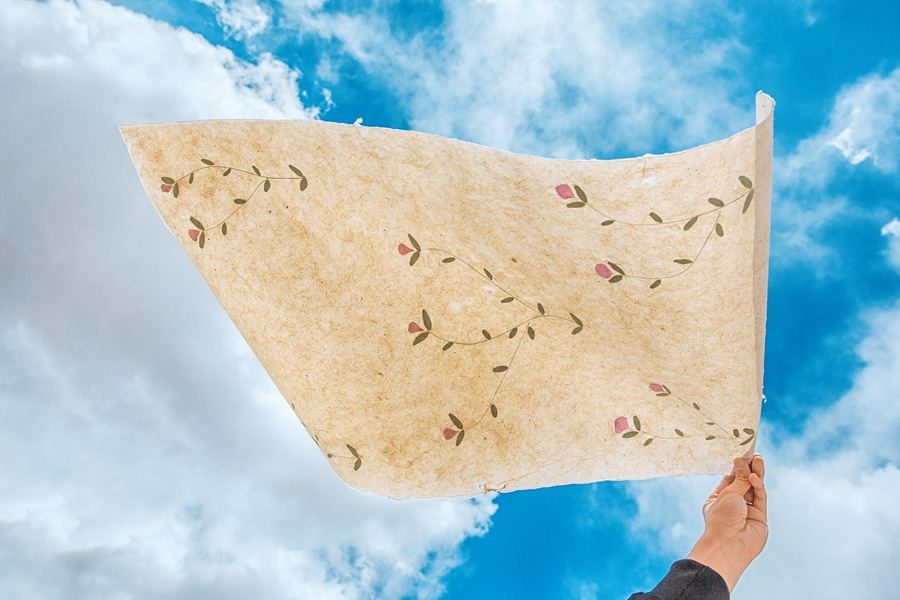
A new type of Tibetan paper for decoration developed by local craftsmen in Shora.
During his career, what has impressed him most was his participation in repairing pattra-leaf scriptures in 2006. The extant pattra-leaf scriptures in Tibet were mainly works of the period from the 8th to 14th century, with their contents covering most facets of traditional Tibetan culture, closely associated with Tibetan Tripitaka (the oldest collection of Buddhist scriptures), thus very valuable for research on the history of Buddhism in Tibet and China-Indian cultural exchanges. Owing to strong local awareness and unique methods in cultural relic protection, further favored by Tibet’s dry climate, extant Tibetan pattra-leaf scriptures have been well preserved. Of the existing less than 1,000 pattra-leaf scriptures, around 60-80 percent have been found in Tibet.
The pattra-leaf scriptures, which were mostly written in Sanskrit, are only learned by a select group. Tsultrim has written a book about the pattra-leaf scriptures protection history, which is how the local cultural protection group noticed him. He did have experience in cultural relic repair work, and had also learned Sanskrit. However, repairing the ancient scriptures is a huge challenge for the team as long-time storage has made the scriptures go mouldy, get rotten, or damaged by worms, plus the fact that the page numbering of pattra-leaf scriptures is different from the traditional Buddhist scriptures.
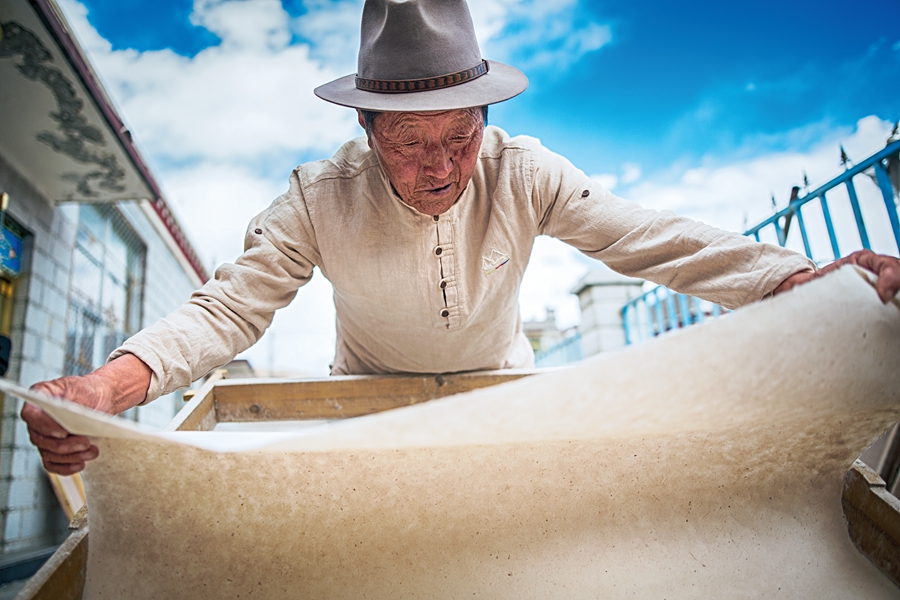
Tsering Dorje peels a piece of aired paper off a screen.
The repair process includes collecting, sorting, photocopying, assembling the shreds of paper and cataloguing. In the assembling step, Tsultrim applied the traditional glue which has been widely used in repairing Buddha statues, trying to diminish fissures without extra damage inflicted.
The challenge also came from the fact that it is difficult to discern some Sanskrit character patterns with circumstantial evidence needed. To better repair the pattra-leaf scriptures, Tsultrim has studied a dozen Sanskrit character types. If the repair team found any part they are not sure about in translation from Sanskrit into Tibetan, its members would record them into the research report, with the aim to draw the attention of the future generation. The protection team follows the principle of checking, accepting, and photocopying on the site, avoiding missing any piece of the relics.
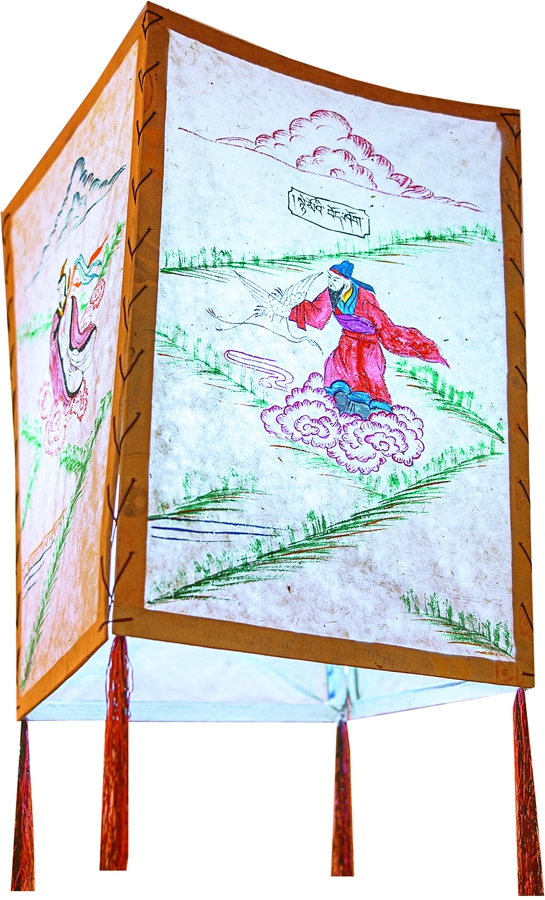
An ornamental lantern made of Tibetan paper.
For six years, in light of Tibetan, Chinese and English documents about pattra-leaf scriptures, Tsultrim and the cultural protection team have visited temples and cultural ruins of 41 counties in Tibet, and interviewed countless ordinary households, trying to get an overall survey of extant pattra-leaf scriptures.
As a devoted repairer of cultural relics, Tsultrim has sought to maintain the original look of ancient articles. During the period of 2001-2005, he completed multiple major tasks of repairing ancient Tibetan books.
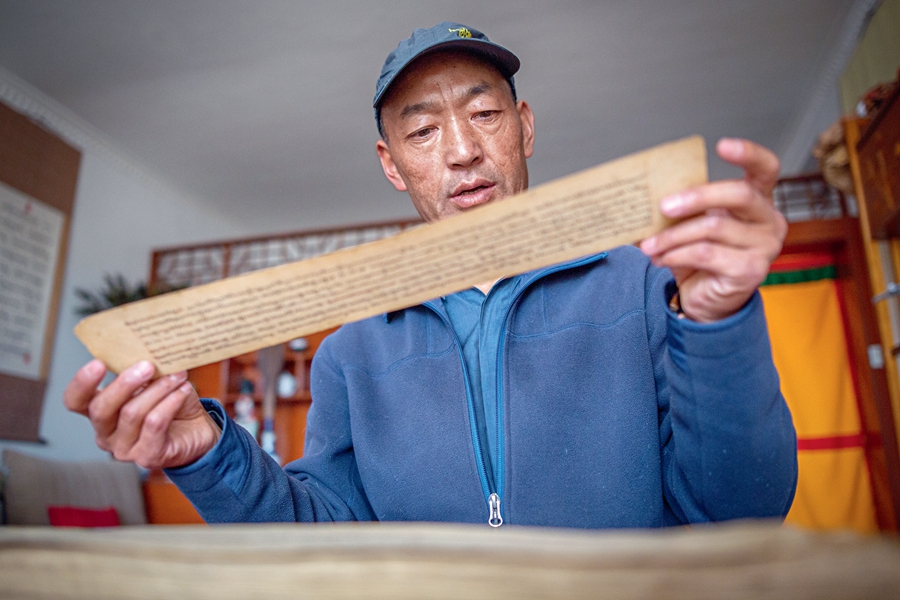
Jumi Tsultrim scrutinizes a page of scripture.
Jumi’s excellent work can be attributed to both his devotion to the profession and his profound cultural background. A graduate of the Tibetan Buddhism College of China, Tsultrim excels in both Tibetan and Sanskrit; meanwhile he is also a calligraphy master. As vice chairman of Tibet Calligraphers Association, hundreds of his calligraphy works in both Tibetan and Sanskrit have been collected by regional organizations. He has garnered multiple awards in this field at both the national level and Tibetan regional level. To better carry forward Tibetan culture, Tsultrim has worked as a volunteer to teach Tibetan calligraphy. To date, his student group has swelled to more than 600 distributed across the whole Tibet Autonomous Region, and some of them have gone on to be teachers themselves, taking the same path as Tsultrim did to promote local traditional culture.
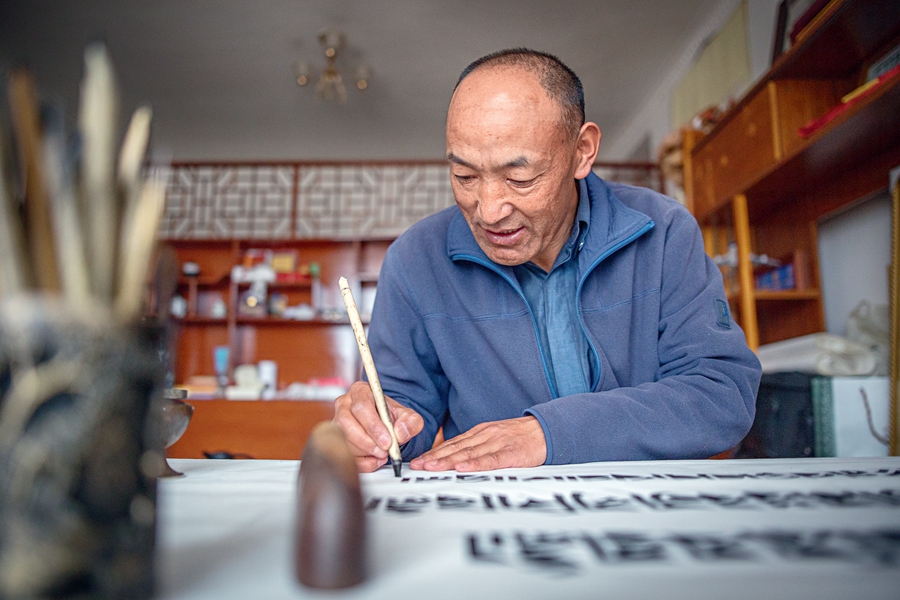
Jumi Tsultrim works on a Sanskrit calligraphic work.
In the new era, traditional Tibetan culture is embracing new development opportunities. And those local cultural masters like Tsultrim are seeing an even larger stage to pursue their career. Their devotion, cultural knowledge, and experience have made them true treasures of the region for cultural inheritance.
ZHAO YAO is a reporter with Tibet.cn.